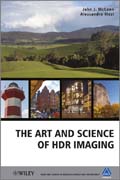
Rendering High Dynamic Range (HDR) scenes on media with limited dynamic rangebegan in the Renaissance whereby painters, then photographers, learned to uselow-range spatial techniques to synthesize appearances, rather than to reproduce accurately the light from scenes. The Art and Science of HDR Imaging presents a unique scientific HDR approach derived from artists understanding of painting, emphasizing spatial information in electronic imaging. Human visual appearance and reproduction rendition of the HDR world requires spatial-image processing to overcome the veiling glare limits of optical imaging, in eyes and in cameras. Illustrated in full colour throughout, including examples of fine-art paintings, HDR photography, and multiple exposure scenes; this book uses techniques to study the HDR properties of entire scenes, and measures the range of light of scenes and the range that cameras capture. It describes how electronic image processing has been used to render HDR scenes since 1967, and examines the great variety of HDR algorithms used today. Showing how spatial processes can mimic vision, and render scenes as artists do, the book also: Gives the history of HDR from artists' spatial techniques to scientific image processing Measures and describes the limits of HDR scenes, HDR camera images, and therange of HDR appearances Offers a unique review of the entire family of Retinex image processing algorithms Describes the considerable overlap of HDR and Color Constancy: two sides of the same coin Explains the advantages of algorithms that replicate human vision in the processing of HDR scenes Provides extensive data to test algorithms and models of vision on an accompanying website www.wiley.com/go/mccannhdr ÍNDICE: Series Editor Preface. Preface. Acknowledgements. Section A HISTORY OF HDR IMAGING. 1 HDR Imaging. 1.1 Topics. 1.2 Introduction. 1.3 Replicas and Reproductions. 1.4 A Choice of Metaphors for HDR Reproduction. 1.5 Reproduction of Scene Dynamic Range. 1.6 HDR Disciplines. 1.7 Outline of the Text. 1.8 Summary. 1.9 References. 2 HDR Tools and Definitions. 2.1 Topics. 2.2 Introduction. 2.3 Pixels. 2.4 Dynamic Ranges. 2.5 Measuring Light. 2.6 Measuring ColorSpaces. 2.7 Image Reproduction. 2.8 Contrast. 2.9 Digital Imaging. 2.10 Summary. 2.10 References. 3 HDR in Natural Scenes. 3.1 Topics. 3.2 Appearance in HDR and Color Constancy. 3.3 Summary. 3.4 References. 4 HDR in Painting. 4.1 Topics. 4.2 Introduction. 4.3 Ancient Painting. 4.3 Su Children Playing on a Winter Day, detail in Sung dynasty scroll (1130-1160), National Palace Museum, Taipei. 4.4 Perspective. 4.5 Chiaroscuro. 4.6 Gerritt van Honthorst (Gherardo delle Notti). 4.7 Rembrandt van Vijn. 4.8 John Constable. 4.9 John Martin. 4.10 Impressionism. 4.11 Photorealism. 4.12 Summary. 4.13 References. 5 HDR in Film Photography. 5.1 Topics. 5.2 Introduction. 5.3 Multiple exposures in the 1850s. 5.4 H. P. Robinson. 5.5 Hurter Professional Amateur Photography. 5.8 20th Century Corporate Photography. 5.9 20th Century Control of Dynamic Range. 5.9 O ther Silver-Halide Stories. 5.10 Summary. 5.11 References. 6 Ansel Adamss ZoneSystem. 6.1 Topics. 6.2 Introduction. 6.3 Compressing the HDR World into the LDR Print. 6.4 Visualization. 6.5 Scene Capture. 6.6 Performing the Score. 6.7Moonrise, Hernandez. 6.8 Apparent vs. Physical Contrast. 6.9 Summary. 6.10 References. 7 HDR Electronic Image Processing. 7.1 Topics. 7.2 Introduction. 7.3Human Spatial Vision. 7.4 E lectronic HDR Image Processing. 7.5 Summary. 7.6 References. 8 Computer Graphics. 8.1 Topics. 8.2 Introduction. 8.3 E arly Years: the 60s. 8.3 E arly Digital Image Synthesis: the 70s. 8.4 The turning point: the 80s. 8.5 Computational Photorealism: from 90s. 8.7 Summary. 8.8 References. 9 Review of HDR History. 9.1 Topics. 9.2 Summary of Disciplines. 9.3 Review. 9.4 Summary. 9.5 References. Section B MEASURED DYNAMIC RANGES. 10 Actual Dynamic Ranges. 10.1 Topics. 10.2 Introduction. 10.3 Dynamic Range of Light Sensors. 10.4 Bits per Pixel. 10.5 Dynamic Range of Display Devices. 10.6 Interactions of Pixels in Images. 10.7 Summary. 10.8 References. 11 Limits of HDR Scene Capture. 11.1 Topics. 11.2 Introduction. 11.3 HDR Test Targets. 11.4 Cameraveiling glare limits. 11.5 Glare in Film Cameras. 11.6 Review. 11.7 Summary. 11.8 References. 12 Limits of HDR in Humans. 12.1 Topics. 12.2 Introduction. 12.3 Visual Appearance of HDR Displays. 12.4 The von Honthorsts Painting and the 4scaleBlack HDR Target. 12.5 HDR Displays and Black and White Mondrian. 12.6HDR and Tone Scale Maps. 12.7 HDR Displays and Contrast. 12.8 Summary. 12.9 References. 13 Why does HDR improve images? 13.1 Topics. 13.2 Introduction. 13.3 Why are HDR images better? 13.4 Are multipl
- ISBN: 978-0-470-66622-7
- Editorial: John Wiley & Sons
- Encuadernacion: Cartoné
- Páginas: 384
- Fecha Publicación: 21/10/2011
- Nº Volúmenes: 1
- Idioma: Inglés
